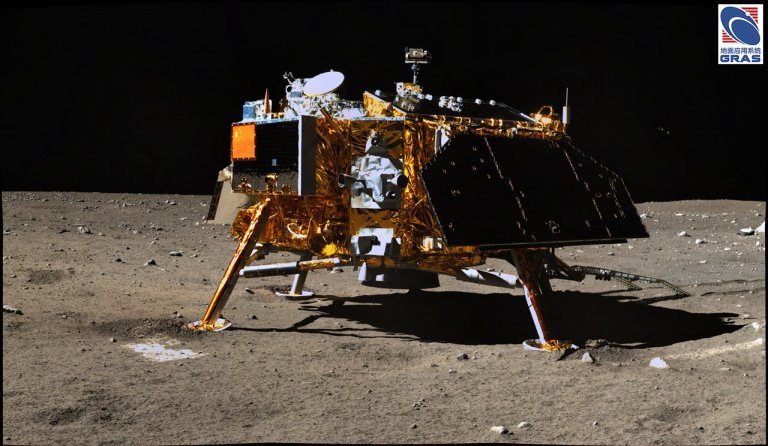

The Chang'e-3 lander, imaged by the Yutu rover. Their backups will be used for Chang'e-4 on the far side of the Moon. (Photo: Chinese Academy of Sciences)
With the launch of the Chang'e-5 Moon sample return probe this November, China will complete its original three-step programme to separately orbit, land on, and collect materials from the Moon.
But the country's ambitions won't stop there, according to Ye Peijian, a chief commander of the China Lunar Exploration Project (CLEP).
Ye told media on Wednesday that the pioneering Chang'e-4 mission to the lunar far side in late 2018 - utilising the backup lander and rover from the Chang'e-3 mission - will kick off a brand new fourth phase of exploration.
The mission involves first sending a relay orbiter to a Lagrange point beyond the Moon in summer 2018 to facilitate communications with the lander and rover on the lunar far side, which due to tidal locking never faces Earth.

Above: A view of the far side of the Moon and the distant Earth, captured by the service module for the 2014 Chang’e 5-T1 mission (Chinese Academy of Sciences).
Later missions will then target the north and south poles of the moon, Ye says, to undertake surface exploration, resource development and related technology validation.
The lunar poles are of tremendous scientific interest and could offer new insights into the origins and evolution of the Earth-Moon system and the solar system itself, according to a 2012 paper by Ian Crawford, a professor of planetary science and astrobiology, and others.
The lunar poles also potentially contain areas of water ice, preserved in permanently shadowed craters, and other places almost permanently bathed in sunlight, both of which could be extremely useful in terms of resources and for future human outposts.
The missions are likely to take place in the early to mid-2020s.
More immediately the Chang'e-5 probe will be shipped to the Wenchang Satellite Launch Centre on Hainan island in August in preparation for launch on a Long March 5 rocket in late November.

Above: The Chang'e-5 reentry capsule (Framegrab/CCTV).
The mission will feature China's first automated moon surface sampling, and the first such mission by any country for over 40 years.
The complex mission involves landing on the Moon, collecting samples, take-off, and an unmanned docking in a lunar orbit about 380,000 km from Earth, and returning home at a speed close to second cosmic velocity, testing reentry technology.
Should Chang'e-4 and Chang'e-5 be successful, the backup sample return probe Chang'e-6 is expected, though not officially approved, to attempt a sample return from the far side, possibly around the lunar polar regions.
Jupiter and asteroid plans
"China is also preparing for the exploration of asteroids and Jupiter, as part of its plans for deep-space exploration," Ye Peijian told Xinhua (Chinese).
Such plans were noted in the Chinese government's space policy 'white paper' released in December.
Ji Jianghui, a researcher at Purple Mountain Observatory under the Chinese Academy of Sciences, in February outlined a proposal for asteroid sampling.
The mission would see China launch a probe in 2022 to first fly alongside and orbit near-Earth asteroid Apophis, then flyby asteroid 2002 EX11, and finally rendezvous with and land on asteroid 1996 FG3. (gbtimes)

86-10-68597521 (day)
86-10-68597289 (night)

86-10-68511095 (day)
86-10-68512458 (night)

cas_en@cas.cn

52 Sanlihe Rd., Xicheng District,
Beijing, China (100864)

